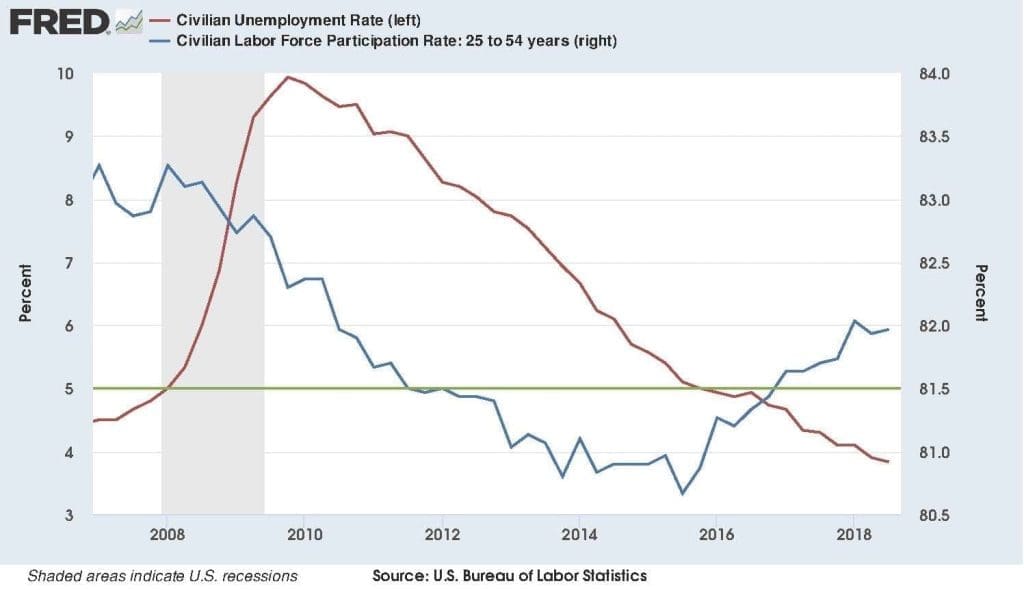Five percent was the magic number.
For years after the Great Recession officially ended in 2009, the recovery seemed to be proceeding at a snail’s pace. Even as the unemployment rate fell, it appeared that millions of Americans who had lost work during the recession had given up on looking for jobs.
There were worried analyses that the problem was a secular one, not a cyclical one. If many of these people could not find work because their skills were no longer useful in a changed economy, or at least believed that to be the case, then monetary stimulus from the Federal Reserve wasn’t going to help.
Three years ago, the unemployment rate fell to 5%, exactly half the peak rate that had been reached in October 2009. But a significant part of that gain seemed to have come from people leaving the work force, and therefore not being counted as unemployed, even though they did not have jobs.
In September 2015, 80.6% of people aged between 25 and 54 – the prime working years – were in the labor force. That was well below the 83% figure in place in 2007, on the eve of the Great Recession. But it was then that the labor force participation rate started to recover. Since then, as more and more people have found jobs, the proportion of prime-age people in the labor force has grown. It is not yet back to pre-recession levels, or even to 2009 levels, but it seems to be on the way.
In September, the Bureau of Labor Statistics reported Friday, the participation rate for people aged 25-54 was 81.8%–about halfway back to its 2007 level. But that recovery has gone unnoticed by many, as the participation rate for the entire labor force – as calculated by the Labor Department, has barely budged.

How can that be? Demographics is part of the answer. The government counts everyone over 16 as being of working age, unless they are either institutionalized or in the military. Back in 2006, 54 percent of the working age population was between 25 and 54. Now the figure is 49%. Then 29% were over 55. Now 36% are.
Another part of the answer is that a smaller proportion of people under 25 are in the work force – with the biggest decline among teenagers. That, of course, may be good news, if more young people are staying in school. But there may be something else at work. The Federal minimum wage is $7.25 an hour, the same as it was in 2009. Adjusted for inflation, it is down 15%. Teenagers are most likely to get minimum wage jobs, and some may think such jobs are not worth it anymore.
As it happens, the participation rate for people over 55 went up as the Great Recession began. With homes and 401k accounts worth much less than they had been, fewer people were interested in retiring if they could help it. That increase halted around 2012, and the rate has since dipped a bit.
What might we expect for the jobless rate going forward? The healthy gains for payrolls so far this year make a forecast of additional gains for prime age participation quite reasonable. That figure could rise to about the levels seen on the eve of the Great Recession. If the climb for prime age participation advances at the pace registered over the past two years, it will have worked its way back to 83% by the autumn of 2020.
Superimposed on this backdrop will be the powerful continuation of the mushrooming of the over 65 cohort, as baby boomers enter the golden years in droves. The Bureau of Labor Statistics expects that the 65 and over category will climb by 3.7 million over the next two years, accounting for a whopping 75% of total population growth. The number of people between 25 and 54 is expected to rise by less than 1 million.
What do we get if we combine rebounding prime age and sideways teenage participation with mushrooming numbers of oldsters? Roughly speaking if the overall participation rate continues to go sideways, the labor force will grow at about 130,000 per month.
That translates to labor force gains well below the current pace of job growth. At some point, the arithmetic does not work out. Absent a slowdown for job growth – or a much more substantial rise in the labor force — that would put the unemployment rate at around 2.5% late in 2020.
A jobless rate below 3%? Scanning the jobless rate, 1950 to present, there only four months, all in 1954, wherein the jobless rate was below 3%. A better bet? Somewhere between here and there, forces come into place that will slow that trajectory.
The arithmetic on available workers does not have to be so glum. If the labor market does stay strong, we might expect an increase in the number of foreigners who want to seek opportunities in the United States.
Immigrants are much more likely than the overall population to be of working age, neither very young nor old, so they do more to increase the labor force than might be expected if one only looked at overall numbers.
Would politics allow that? Not now.
